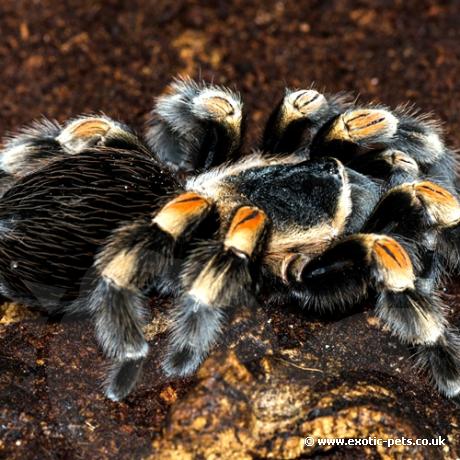

The classic pet tarantula and arguably the most recognisable spider in the world. A great species for beginners and a must for any serious collection.
| Lifestyle | Terrestrial |
|---|---|
| Adult Size | 14-15cm |
| Growth Rate | Slow |
| Environment | Scrubland / Deciduous rainforests |
| Suitability | Beginner |
| Temperament | Docile |
This is a docile and medium sized terrestrial spider reaching 6-7cm bodylength when fully grown.
It has a black base colouration all over, with pale orange setae hair on its abdomen and legs. The carapace has a distinct shaped pattern and colour which forms a black centre with pale orange all around with edge. The name 'Red Knee' actually describes the patella (knee joint) which is red to orange in apperance.
This species inhabits tropical sub-humid forests along the Pacific coast of Colima, Michoacan (Mexico).
In its natural habitat the preciptation levels are always below 1200mm per year. The majority of this rainfall happens over a period of 5 months between June and October. Temperatures do not vary greatly during the year with mean temperatures of 28ºC daytime and 20ºC at night.
Brachypelma smithi are opportunist tarantulas and normally live in burrows no deeper than 30cm. This could be a disused rodent burrow or a simple opening underneath a rock or tree. The burrow itself normally consists of an entrance leading to a chamber. The chamber is where the spider normally rests and forms a safe place for it molt.
The Mexican Red Knee Tarantula remains the most recognisable and popular pet spider in the hobby and as such is protected by CITES from collection in their native habitat of Mexico. All spiders offered here in the UK must be of captive bred origin.
This spider needs to be kept in a terrestial style plastic faunarium or suitable glass enclosure. Enclosure size is entirely dependent on the size of the spider your wishing to house; if your unsure of which size enclosure is suitable then please contact us. We also offer a tarantula starter kit for terrestrial spiders of juvenile size or above. Spiderlings should be kept in plastic vials or deli containers until big enough to house into larger enclosures without them escaping.
Heat can be provided simply by a small heat mat at the side or underneath the enclosure. We would recommend keeping the tarantula between 24-28ºC daytime, with a nightime temperature drop to 20ºC.This species does not require high humidity, we would recommend dampening down half of the enclosure floorspace (water bowl side) and letting the other half dry out. This can be done with the aid of a small spray bottle and also by deliberately overflowing the waterbowl.
For substrate provide 7-10cm of loose coir or peat. Coir can be purchased in either block form (which expands to provide several litres) or in a loose bag form. Peat is available in loose bags only. As an alternative, there is also a selection of specialist invert substrates.
Provide a shelter for the tarantula to feel secure, this can be as simple as a coconut hide or a piece of curved cork bark for them to get under or behind. Don't be alarmed if your spider ignores the retreat and sits out in the open.
A water bowl for drinking is also advisable, but you may not see your tarantula use it often. Tarantulas generally feed on a variety of suitably sized live food; including crickets, mealworms, cockroaches and locusts. Most species of tarantula for example, will eat no more than a couple of suitable sized crickets per week. To maintain your feeder insects for longer, try one of our live food care kits.